アクティビティーステートメントのキャッシュ・レポートの項目に証券とコモディティの口座間の移動が表示される理由
IBKRでは規制のため、口座内の有価証券資産をコモディティ資産と分別することを義務とされています。 コモディティ資産には、先物ポジションのオプションの市場価値や、コモディティの先物や先物ポジションのオプトアウトのために証拠金として必要となる現金が含まれることがあります。 コモディティのポジションの必要証拠金は定期的に計算し直され、証拠金額が下がる場合には、コモディティの必要証拠金として余る分が口座のコモディティ側から有価証券側に移動します。 また、コモディティの必要証拠金額が上がる場合、IBKRでは有価証券側で利用可能な現金をコモディティ側に移します。 SIPC保険は口座内のコモディティ側ではなく、有価証券側の資産を対象としているため、定期的な移動は現金残高に対する保護が最大となるように行われます。 なお、これらの仕分けはお互いに相殺されるため、口座内の現金残高の合計には影響しません(アクティビティーステートメントの現金残高項目内の、「合計」コラムをご覧下さい)。
口座に入金している間は強制決済を待ってもらうことはできますか?
IBKRの証拠金順守にかかる方針では、口座に証拠金の違反や不足が発生している場合、送金やその他の入金を受付けることができません。 証拠金違反や不足が発生した場合、口座は即座に強制決済の対象となります。成行注文は自動で強制決済され、口座内のポジションは全て強制決済の対象となります。特定の市場状況によっては、不足の対処に手動の強制決済がより適していることがあります。
口座に入金または送金される資金は、それらがすべての適切な資金および銀行ルートを通過し、正式に口座に入金されるまではリスクの観点から考慮されません。強制決済のシステムは、証拠金違反や不足が発生し次第起動するようにプログラムされ、自動化されています。
プライムクライアントのための重要事項: 弊社以外での取引約定は、取引日における米国東部標準時における午後9時、または取引が報告され外部と確認照合される時点のどちらか遅い方まで、証拠金目的で適格と考慮されないため、外部における約定はリアルタイムの不足を解消する手段にはなりません。また、満期の近づくオプションを満期日に取引することにより、報告の遅延や間違いが発生し、不適切な証拠金計算や権利行使および割当てにつながることがあるためお勧め致しません。満期となるオプションを満期日に弊社以外でお取引される場合には、米国東部標準時における午後2:50までにFTPファイルの読み込みを行い、またご自身のリスクにて行っていただきますようお願い致します。
米国超小型株にかかる規制
イントロダクション
未登録の有価証券の販売に関する規制を遵守し、公開されていない株式の取引に伴う手作業を最小限にとどめるため、IBKRでは米国の超小型株に一定の制限を設けています。下記はこれら規制のリスト、およびこれに関連してよくあるご質問をまとめたものになります。
超小型株にかかる規制
- IBKRでは、資格対象となるお客様からの超小型株の移管のみを受付けており、以下の条件を達成している口座が対象となります: (1) 株式(移管前または後を問わず)を500万ドル以上保有する口座、または運用資産総額が2,000万ドル以上のファイナンシャルアドバイザーのクライアント、 かつ (2) 米国超小型株の占める割合が保有資産の半分以下であること。
- IBKRでは、対象となるお客様が株式を公開市場で購入したこと、またはSECに登録したことを確認できる場合に限り、米国超小型株のブロックの移管を受付けております1。
- IBKRでは、OTCがCaveat Emptor、またはGrey Marketとしてデザインした米国超小型株の移管、またはオープン注文を、いかなるお客様からも受け付けることができません1。該当する株式をポジションに既にお持ちのお客様は、ポジションの決済は可能です。
- IBKRでは、弊社で建てたショートポジションをカバーするための米国超小型株の移管を受付けておりません。
- 約定のみのお客様(IBKRで約定し、他社で決済される場合)は、IBKR口座において米国超小型株のお取引はできません。(米国登録のブローカーのお客様は例外となることがあります)
超小型株に関してよくあるご質問
米国超小型株とは何ですか?
「超小型株」とみなされるのは (1) 店頭取引される株式、または (2) NasdaqやNYSE Americanに上場されている株式のうち、時価総額が5000万ドルから3億ドルの間で、5ドル以下で取引されているものを指します。この方針において超小型株とは、時価総額が5000万ドル以下の米国の公開企業の株式で、ナノキャップ株とも呼ばれ、一般的に超小型株に関連する市場で取引されるものを含みます。
短期的な株価の変動によって再分類が繰り返される事態を避けるため、米国超小型株に分類された銘柄は、30日連続で時価総額と株価の両方が、それぞれ3億ドルと5ドルを超えるまで、現在の分類が継続されます。
超小型株は低価格のものが多いため、一般的にペニーストックと呼ばれています。IBKRでは、低価格で取引されている銘柄で最近に時価総額が大きくなったものなど、例外を設けることがあります。また、IBKRでは非米国企業のADRは超小型株とはみなしません。
超小型株はどこで取引されますか?
超小型株は通常、証券取引所ではなく、店頭市場で取引されます。OTC Bulletin Board(OTCBB)やOTC Markets Group(OTCQX、OTCQB & Pinkなど)が経営する市場などのOTCシステムにおいて、マーケットメーカーによって電子的にクオートされることがよくあります。また、Caveat Emptor、Other OTCやGrey Marketと呼ばれる、上場していない銘柄もこのカテゴリーに含まれます。
また、米国の規制当局はNasdaqまたはNYSE Americanに上場している銘柄のうち、取引価格が$5以下で、時価総額が3億ドル以下のものも超小型株とみなします。
資格対象となるクライアントから移管されてくるポジションの一つ以上が超小型株の場合にはどうなりますか?
IBKRが超小型株のブロックを含む移管を受けた場合、資格対象となるクライアントが、株式が公開市場で購入されたか(他ブローカー経由で公開市場での購入)、 S-1またはこれと同様の登録書によってSECに登録されたことを証明する適切な書類を提出しない限り、IBKRは移管に含まれる超小型株ポジションの売却を制限する権利を有します。
対象となるお客様は、株式が公開市場で購入されたことの証明として、これを反映した、信頼できるブローカーからの証券取引明細書、またはトレード・コンファメーションをご提出ください。対象となるお客様は、株式が登録されたSECファイル番号(および株式が登録書に記載されているものであることを必要な書類)のご提供によって、株式の登録を証明することができます。
注意事項: 規制対象となる株式を他社へ移管することは、すべてのお客様に可能になっています。
IBKRではプライム口座に規制を設けていますか?
アクティビティにプライムサービスが含まれるお客様は、IBKRが執行ブローカーから受け入れることに同意した取引のみに対し、資格対象となるものとみなされます。プライム口座は、IBKRで超小型株を売却することができますが、これらの株式には、IBKRが上記の手続きに基づいて株式の再売却が可能であることを確認するまで、規制が適用されます。
公開市場で購入した株式の規制を解除するには、株式が公開市場で購入されたことが記載される公式な口座明細書か、この内容のレターを執行した株式会社に会社のレターヘッド付きの紙に署名を入れて発行してもらって下さい。レターか明細書には以下の情報が含まれている必要があります。また、株式が募集によって取得された場合には、レターや明細書には、関連する登録届出書の文書やリンクを含めて、株式がその一部であることを明確にする必要があります。
証券会社からのレターに含まれるべき内容:
1) IBKR口座の番号
2) IBKR口座の名義
3) 取引日
4) 決済日
5) シンボル
6) サイド
7) 価格
8) 数量
9) 執行時間
10) 取引所
11) 署名が入っていること
12) 会社の公式レターヘッドを使用すること
サマリー: ロングポジションの規制がなくなった場合には、ロングの売り取引が受付可能になります。ショートの売り取引も受付可能になります。買いのロング取引は受付可能ですが、規制の解除に十分な情報をコンプライアンスが確認できるまで、ポジションには規制がかかったままとなります。買いのカバー取引および日中の往復取引はできません。
購入した株式が、Grey MarketやCaveat Emptorに再分類された場合にはどうなりますか?
IBKR口座で購入した株式が、後日、Caveat Emptor、またはGrey Market株式に分類された場合、ポジションの維持、決済、移管は可能ですが、増やすことはできません。
超小型株が口座で取引できなくなるにはどういった理由がありますか?
超小型株の取引に規制が設けられるにあたっては、2つの基本的な理由があります:
- 発行体との提携の可能性: 米国証券取引委員会(「SEC」)ルール144では、発行体の関連会社による株式(超小型株を含む)の取引に一定の規制が設けられています。ルール144(「ルール144境界値」)の取引量の境界値に近い超小型株の取引活動や保有が見られた場合、IBKRではコンプライアンスによる審査が完了するまで、超小型株の取引に規制を設けることができます。
- 超小型株の移管: IBKR口座に最近、超小型株を移管された場合には、コンプライアンスによる審査が完了するまで、この有価証券の取引に規制がかかることがあります。
上記の理由のいずれかに該当する場合には有価証券の取引に規制が設けられ、アカウント・マネジメント経由でお客様にメッセージが送信されます。通知には規制の理由および解除にあたってお客様に必要となる手順が記載されます。
なぜ私が超小型株発行体と関連性があるものとみなされる可能性があるのでしょうか?
「関連会社」とは、発行体をコントロールする関係にある執行役員、取締役、大株主などの人物を指します。
ルール144は、超小型株を含める有価証券すべてに適用されます。しかしながら、超小型株の取引に関連するリスクが高まっているため、お客様の超小型株の取引および/または保有がルール144の境界値に近い場合、IBKRでは超小型株の取引に規制を設けます。 この規制は、お客様の潜在的な関連性に関するコンプライアンス調査が行われるまで有効となります。
潜在的な関連性確認の審査を受けるにあたり、なぜ2週間ごとに新しく審査を頼まなければいけないのでしょうか?
お客様の関連性ステータスは、IBKRが上記の潜在的関連性の審査を完了した直後に変更される可能性があります。このためIBKRでは、お客様の取引活動や超小型株の保有量がルール144の境界値に近い場合、2週間ごとに潜在的関連性の確認を行うことが適切であると考えております。
IBKRが米国超小型株として指定している株式のリストはどこから確認できますか?
IBKRで米国超小型株と指定している株式のリストは: www.ibkr.com/download/us_microcaps.csvよりご確認いただけます。
リストは毎日更新されます。
超小型株の詳細はどこから入手できますか?
関連するリスクを含める超小型株の詳細は、SECのウェブサイトをご参照ください: https://www.sec.gov/reportspubs/investor-publications/investorpubsmicrocapstockhtm.html
-----------------------------------------------------------
1これには様々な方法による移管(ACATS,、DWAC、FOPなど)、カナダで上場される銘柄の米国での等価物への「サウスバウンド」移管による変換、既存のショートポジションをカバーするための移管、IBプライムのお客様が他ブローカーで約定しIBKRでクリアリングするものなどが含まれます。
スマートフォンを利用してIBKRにドキュメントを送信する方法
インタラクティブ・ブローカーズでは、お客様がスキャナを利用できない場合にドキュメントのコピーを受付けています。スマートフォンで必要ドキュメントの写真を撮ってお送りください。
こちらでは、以下のスマートフォンのOSで、写真を撮ってメールで送信する方法をご説明致します:
スマートフォンで写真を撮ってメールで送信する方法をすでにご存知の方は、こちらの「メールの送信先および件名に含める内容」をご覧ください。
iOS
1. スマートフォン画面の下から上にスワイプして、カメラのアイコンをタップしてください。
カメラのアイコンがない場合には、ホーム画面のカメラアプリのアイコンをタップしてください。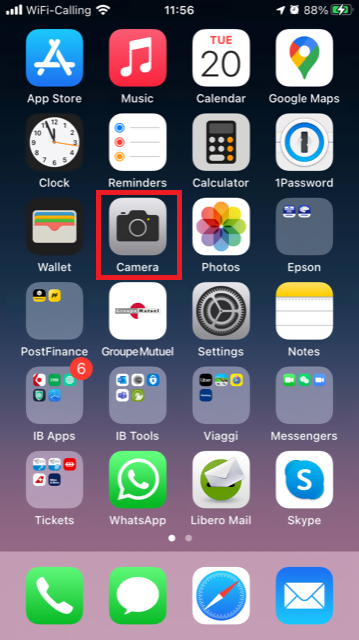
通常はこの時点でリアカメラが有効化されています。フロントカメラが有効化されている場合には、切り替えボタンをタップしてください。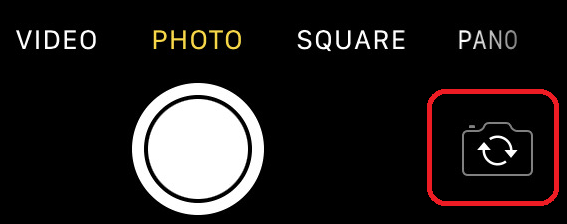
2. ドキュメントにiPhoneをかざし、必要な部分またはページを枠内に入れます。

3. 光が十分に当たっていて、ポジションのせいでドキュメントに影ができないようにしてください。 スマートフォンが震えないように、手でしっかり持ってください。シャッターボタンをタップして写真を撮ります。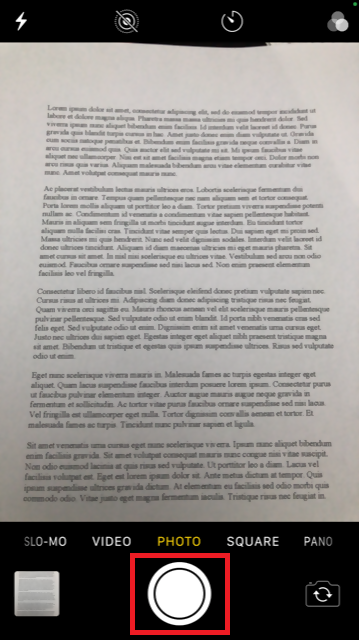
4. 左下のサムネイルイメージをタップして、写真にアクセスしてください。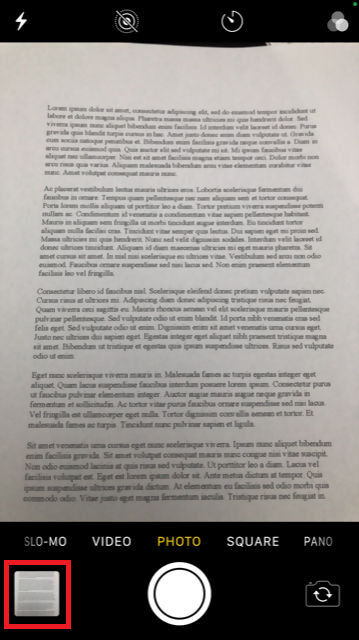
5. 写真がはっきりしていて、ドキュメントが読めることを確認してください。詳細を見る場合には、2本の指で写真を拡大して確認してください。

良く見えない場合や、光が十分でない場合には、前の手順を繰り返して、はっきりとした写真を撮ってください。
6. 画面の左下にある共有アイコンをタップしてください。
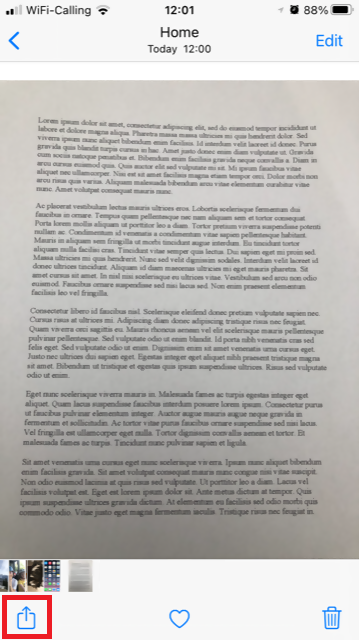
7. メールアイコンをタップしてください。
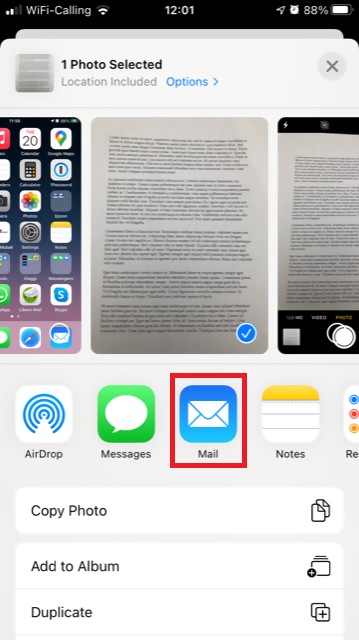
注意事項: メールの送信にはこの機能が設定されている必要があります。この手順を使い慣れていない場合には、メールプロバイダーにお問合せください。
8. メールの送信先:と件名:欄の表示の仕方は、こちらをご参照ください。メールが完了したら、右上の上向きの矢印をタップして送信してください。
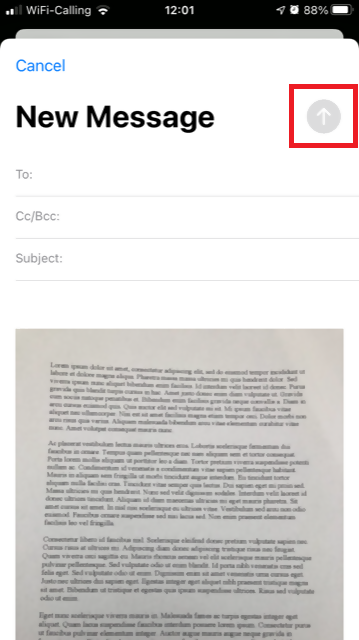
アンドロイド
1. アプリのリストを開いて、カメラアプリを起動するか、ホーム画面から起動してください。スマートフォンのモデル、ブランド、または設定によってアプリの名前が異なることがあります。

通常はこの時点でリアカメラが有効化されています。フロントカメラが有効化されている場合には、切り替えボタンをタップしてください。
2. ドキュメントにスマートフォンをかざし、必要な部分またはページを枠内に入れます。

3. 光が十分に当たっていて、ポジションのせいでドキュメントに影ができないようにしてください。 スマートフォンが震えないように、手でしっかり持ってください。シャッターボタンをタップして写真を撮ります。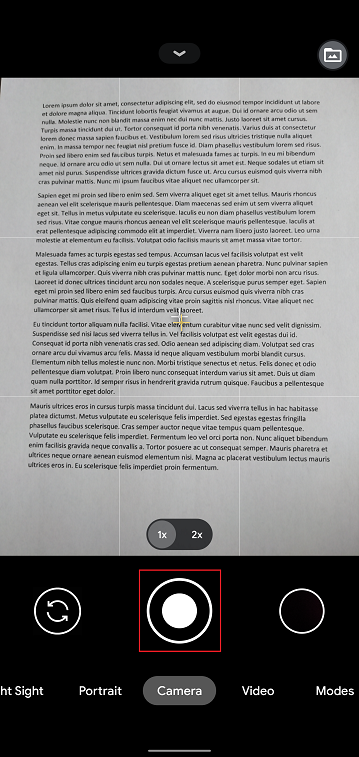
4. 写真がはっきりしていて、ドキュメントが読めることを確認してください。詳細を見る場合には、2本の指で写真を拡大して確認してください。

良く見えない場合や、光が十分でない場合には、前の手順を繰り返して、はっきりとした写真を撮ってください。
5. 画面の右下にある、黒丸のアイコンをタップしてください。
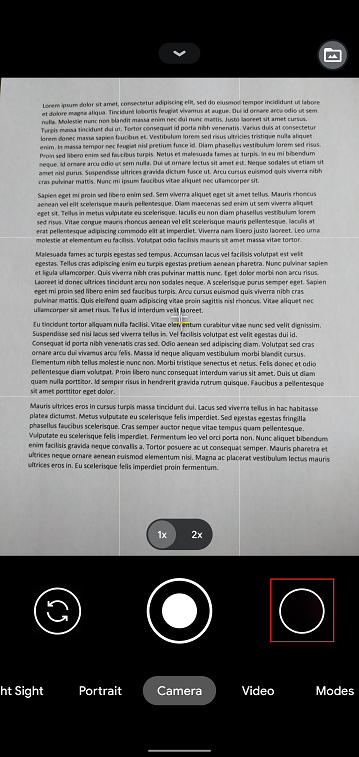
6. 画面の左下にある共有アイコンをタップしてください。
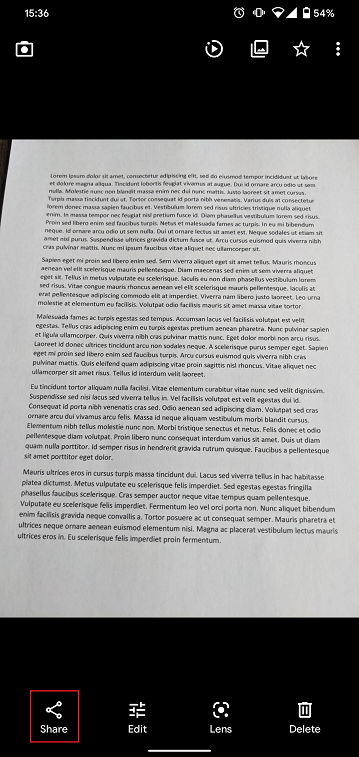
7. ここで表示される共有メニューから、スマートフォンに設定されているメールクライアントのアイコンをタップしてください。下記の例ではGmailですが、お客様の設定により別の名前のことがあります。
.png)
注意事項: メールの送信にはこの機能が設定されている必要があります。この手順を使い慣れていない場合には、メールプロバイダーにお問合せください。
8. メールの送信先と件名欄の表示の仕方は、こちらをご参照ください。メールが完了したら、右上の飛行機の矢印をタップして送信してください。

メールの送信先および件名に含める内容
メールの作成にあたっては、下記のインストラクションをご参照ください:
1. 送信先:の欄に以下を入力してください:
- ヨーロッパ以外の国に居住される方は、newaccounts@interactivebrokers.comをご利用ください。
- ヨーロッパに居住される方は、newaccounts.uk@interactivebrokers.co.ukをご利用ください。
2. 件名:の欄には、下記をすべて入力してください:
- お客様の口座番号(通常はxが数字で、Uxxxxxxxのフォーマットになります)またはユーザー名。
- ドキュメントの送信目的。以下の名前付け規則を使用してください:
- PoRes:居住地住所を証明する書類
- PID:本人確認書類
資金の送金にかかる規制
イントロダクション
弊社ではマネーロンダリング防止プログラムの一環として、特定のタイプの入出金には規制を設けています。これらの制限はアンチマネーロンダリングのリスクがより高いと見られる国に関連する送金に適用され、クライアントの居住地、出金の送り先、ならびにどの通貨で取引されるかなどの要因が考慮されます。1規制の概要は以下の様になります。
規制の概要
- AMLのリスクがより高いとの指定を受ける国に居住するまたは住所を保有するお客様は、やはりAMLのリスクがより高いとの指定を受ける国にある口座に出金する場合、この国に住所を保有していない限りこれはできません。
- AMLのリスクがより高いとの指定を受ける国に居住するまたは住所を保有するお客様は、やはりAMLのリスクがより高いとの指定を受ける国にある口座から入金する場合、この国に住所を保有していない限りこれはできません。
- AMLのリスクがより高いとの指定を受ける国に居住するまたは住所を保有するお客様は、自身の口座からの入金として初めに入金元となった口座のみに出金することができます。
- 出金は基準通貨、自国の通貨、または共通通貨(例:USD、EUR、HKD、AUD、GBP、CHF、CAD、JPYならびにSGD)のみで可能です。
- IBSGのお客様は、SGD、USD、CNH、HKD、ならびにGBPのみでご出金可能です。
- お客様のいらっしゃる場所や銀行の場所には関係なく、弊社では送金先に指定できる銀行の数に規制を設けています。
規制のかかっているオンライン・バンキング指示の作成や、入出金の開始が行われた場合、そういった指示の作成や取引の開始はブロックされ、オンラインのエラーメッセージが表示されます。
1AMLリスクがより高いとされる国を判断する上では、国際金融システムの整合性に対するマネーロンダリング、テロ資金の供給、またその他の脅威に対する対策を推進する政府間機関であるFATF(マネーロンダリングに関する金融活動作業部会) の提供する情報を考慮します。
Funds Transfer Restrictions
INTRODUCTION
As part of its anti-money laundering efforts, IBKR implements restrictions on certain client deposits and withdrawals. These restrictions apply to transfers associated with countries considered to have elevated AML risk and consider factors such as the client’s residency, the withdrawal destination and the denomination of the currency being transferred.1 An outline of these restrictions is provided below.
OVERVIEW OF RESTRICTIONS
- Clients residing or maintaining an address in a country designated as having elevated AML risk may not withdraw funds to an account located in another country that has elevated AML risk unless they also maintain an address in that country.
- Clients residing or maintaining an address in a country designated as having elevated AML risk may not deposit funds from an account located in another country having elevated AML risk unless they also maintain an address in that country.
- Clients residing or maintaining an address in a country designated as having elevated AML risk may only withdraw funds to an account from which that client received a first-party deposit.
- Clients may only withdraw funds in their base currency, their home country’s currency or common currencies (e.g. USD, EUR, HKD, AUD, GBP, CHF, CAD, JPY and SGD).
- IBSG clients may only withdraw in SGD, USD, CNH, EUR, GBP and HKD.
- IBKR may restrict the number of banks that a client may send money to, regardless of the domicile of the client or the bank.
- A change to your base currency requires a minimum of 5 days before withdrawal instructions can be entered and a withdrawal request can be processed.
Note that clients who attempt to create an online banking instruction or initiate a deposit or withdrawal which is restricted will be blocked from creating that instruction or initiating that transaction and will be presented with an online error message.
1In determining whether a country is associated with elevated AML risk, consideration is given to information provided by the Financial Action Task Force (FATF), an intergovernmental organization which promotes measures for combating money laundering, terrorist financing and other related threats to the integrity of the international financial system and other public AML indices.
Deposit Funds with IBKR Mobile Check Deposit
US clients using IBKR Mobile with IB Key two-factor authentication can deposit endorsed checks drawn on a US bank into their account from anywhere using Mobile Check Deposit.
Mobile Check Deposit is NOT supported for: IRAs, MMCs, partitioned accounts or Advisor Masters (Advisors cannot deposit into client accounts).
To use Mobile Check Deposit:
- You must be a US client.
- The check must be drawn on a US bank.
- The check must be properly endorsed.
- You must have IBKR Mobile installed on your phone.
- You must have activated IB Key two-factor authentication on the IBKR Mobile app.
- It must not be your first deposit.
To find out more about how to install IBKR Mobile, visit the IBKR Mobile web page.
- Log into IBKR Mobile, and tap the More menu followed by Transfer & Pay.
- From the Transfer & Pay menu tap Deposit Check.
- If prompted, read and accept the disclosure.
- Set up your deposit:
- a. If you hold multiple accounts with IBKR, select the account for the deposit in the Deposit to field.
- b. Enter the amount of the deposit in the Amount field.
- c. Scan the front and back of your check using the camera function on your phone. You may be asked to allow IBKR Mobile to access your camera. Please be sure that you have properly endorsed your check.
- When you are satisfied with your scanned images, tap Deposit Check at the bottom of the screen.
- Validate with IB Key as required.
- Once the deposit has been approved and processed, the funds are deposited into your IBKR account. Funds are generally available to use within six (6) business days after the deposit has been approved.
- Currently available for US clients and for checks drawn on US banks.
- Requires active IB Key protocol for two-factor authentication.
- To find out the daily limit and 30 day limit on check deposits, tap “What is my daily limit?” on the Deposit Check screen.
U.S. Microcap Stock Restrictions
Introduction
To comply with regulations regarding the sale of unregistered securities and to minimize the manual processing associated with trading shares that are not publicly quoted, IBKR imposes certain restrictions on U.S. Microcap Stocks. A list of those restrictions, along with other FAQs relating to this topic are provided below.
Microcap Restrictions
- IBKR will only accept transfers of blocks of U.S. Microcap stocks from Eligible Clients. Eligible Clients include accounts that: (1) maintain equity (pre or post-transfer) of at least $5 million or, clients of financial advisors with aggregate assets under management of at least $20 million; and (2) have less than half of their equity in U.S. Microcap Stocks.
- IBKR will only accept transfers1 of blocks of U.S. Microcap Stocks where the Eligible Client can confirm the shares were purchased on the open market or registered with the SEC;
- IBKR will not accept transfers1 of or opening orders for U.S. Microcap Stocks designated by OTC as Caveat Emptor or Grey Market from any client. Clients with existing positions in these stocks may close the positions;
- IBKR will not accept transfers of U.S. Microcap Stocks to cover a short position established at IBKR;
- Execution-only clients (i.e., execute trades through IBKR, but clear those trades elsewhere) may not trade U.S. Microcap Stocks within their IBKR account. (IBKR may make exceptions for U.S.-registered brokers);
Microcap FAQs
What is a U.S. Microcap Stock?
The term “Microcap Stock” refers to shares (1) traded over the counter or (2) that are listed on Nasdaq and NYSE American that have a market capitalization of between $50 million to $300 million and are trading at or below $5. For purposes of this policy, the term Microcap Stock will include the shares of U.S. public companies which have a market capitalization at or below $50 million, which are sometimes referred to as nanocap stocks or trade on a market generally associated with Microcap Stocks.
To avoid situations where minor, short-term fluctuations in a stock price cause repeated reclassification, any stock classified as U.S. Microcap will remain in that classification until both its market capitalization and share price exceed $300 million and $5, respectively, for a 30 consecutive calendar day period.
As Microcap Stocks are often low-priced, they are commonly referred to as penny stocks. IBKR may make exceptions, including for stocks traded at low prices that recently had a greater market cap. In addition, IBKR will not consider ADRs on non-US companies to be Micro-Cap stocks.
Where do Microcap Stocks trade?
Microcap Stocks typically trade in the OTC market, rather than on a national securities exchange. They are often electronically quoted by market makers on OTC systems such as the OTC Bulletin Board (OTCBB) and the markets administered by the OTC Markets Group (e.g., OTCQX, OTCQB & Pink). Also included in this category are stocks which may not be publicly quoted and which are designated as Caveat Emptor, Other OTC or Grey Market.
In addition, U.S. regulators also consider stocks listed on Nasdaq or NYSE American trading at or below $5 with a market capitalization at or less than $300 million to be Microcap Stocks.
What happens if IBKR receives a transfer from an Eligible Client where one or more of the positions transferred is a Microcap Stock?
If IBKR receives a transfer containing a block of a Microcap stock, IBKR reserves the right to restrict the sale of any Microcap position(s) included in the transfer unless the Eligible Client provides appropriate documentation establishing that the shares were either purchased on the open market (i.e., on a public exchange through another broker) or were registered with the SEC pursuant to an S-1 or similar registration statement.
Eligible Clients can prove that shares were purchased on the open market by providing a brokerage statement or trade confirm from a reputable broker reflecting the purchase of the shares on a public exchange. Eligible Clients can establish that the shares are registered by providing the SEC (Edgar system) File number under which their shares were registered by the company (and any documents necessary to confirm the shares are the ones listed in the registration statement).
NOTE: All customers are free to transfer out any shares we have restricted at any time.
What restrictions will IBKR apply to Prime accounts?
Clients whose activities include Prime services are considered Eligible Clients solely for the purposes of those trades which IBKR has agreed to accept from its executing brokers. However, while Prime accounts may clear U.S. Microcap Stocks at IBKR, those shares will be restricted until such time IBKR confirms that the shares are eligible for re-sale under the procedures discussed above.
To remove the restriction for shares purchased on the open market, please have the executing broker provide a signed letter on company letterhead or an official Account Statement stating that the shares were purchased in the open market. The letter or statement must also include the below required criteria. Alternatively, if the shares were acquired through an offering the letter or statement must provide documents or links to the relevant registration statement and state that the shares were part of it.
Required Broker Letter Criteria:
1) IBKR Account Number
2) IBKR Account Title
3) Trade Date
4) Settlement Date
5) Symbol
6) Side
7) Price
8) Quantity
9) Time of Execution
10) Exchange
11) Must be signed
12) Must be on Firm's official letterhead
To summarize: Sell Long trades will be accepted if the long position is no longer restricted. Sell Short trades will be accepted. Buy Long trades will be accepted and the position will be restricted until Compliance is provided with sufficient information to remove the restriction. Buy Cover trades and intraday round trip trades will not be accepted.
What happens if a stock you purchase gets reclassified as Grey Market or Caveat Emptor?
If you purchase a stock in your IBKR account that at a later date becomes classified as a Caveat Emptor or Grey Market stock, you will be allowed to maintain, close or transfer the position but will not be able to increase your position.
What are some of the reasons why Microcap Stock trading may be restricted in my account?
There are two primary reasons why you might be restricted from trading in a Microcap Stock:
- Potential Affiliation to Issuer: U.S. Securities and Exchange Commission (“SEC”) Rule 144 places certain limitations on trading of stocks (including Microcap Stocks) by an “affiliate” of the issuer. If IBKR observes trading activity or holdings in a Microcap Stock that are close to the trading volume thresholds under Rule 144 (“Rule 144 Thresholds”), IBKR may restrict the customer from trading the Microcap Stock until a compliance review is completed.
- Transfer of Microcap Stock: If the customer has recently transferred a Microcap Stock into their IBKR account, IBKR may restrict the customer from trading in that security until a compliance review is completed.
If one of the above reasons apply, trading will be restricted in the security and a notification will be sent to the customer’s message center in Account Management. This notification will describe the reason for the restriction and the steps the customer must take before IBKR will consider lifting the restriction.
Why does IBKR consider me to be a potential affiliate of a Microcap Stock issuer?
An “affiliate” is a person, such as an executive officer, a director or large shareholder, in a relationship of control with the issuer.
Rule 144 applies to all securities, including Microcap Stocks. However, given the heightened risks associated with trading Microcap Stocks, if a customer’s trading and/or holdings in a Microcap Stock are close to the Rule 144 Thresholds, IBKR will restrict the customer’s trading in the Microcap Stock. This restriction will remain in effect pending a compliance review into the customer’s potential affiliate status.
For the Potential Affiliate review, why do I need to ask for a new review every two weeks?
A customer’s affiliate status may change soon after IBKR completes the above-referenced Potential Affiliate review. As such, IBKR believes it is appropriate to refresh a Potential Affiliate review every two weeks if a customer’s trading activity and/or holdings in the Microcap Stock remain close to the Rule 144 Thresholds.
Where can I find a list of stocks that IBKR has designated as U.S. Microcaps?
A list of stocks designated as U.S. Microcaps by IBKR is available via the following link: www.ibkr.com/download/us_microcaps.csv
Note that this list is updated daily.
Where can I find additional information on Microcap Stocks?
Additional information on Microcap Stocks, including risks associated with such stocks may be found on the SEC website: https://www.sec.gov/reportspubs/investor-publications/investorpubsmicrocapstockhtm.html
-----------------------------------------------------------
1This includes transfers by any method (e.g., ACATS, DWAC, FOP), conversion of Canadian listings to their U.S. equivalent via “Southbound” transfer, transfers to cover existing short positions, IB Prime customers executing with other brokers and clearing to IBKR, etc.
South African Rand (ZAR) - Onshore/Offshore
Explanation of Onshore/Offshore South African Rand (ZAR)
Background
The South African Reserve Bank (SARB) has currency exchange control rules in place for South African residents. A South African resident is a person (i.e. a natural person, body corporate, foundation, trust or partnership) whether of South African or any other nationality who has taken up residence, is domiciled or registered in the Republic of South Africa (RSA). A resident account is also the account of persons resident, domiciled or registered in the Common Monetary Area (CMA). The CMA comprises of the Republic of South Africa, Lesotho, Namibia and Swaziland. There are no exchange control restrictions between the members of the CMA and they form a single exchange control territory.
The rules stipulate that there is a yearly limit placed on the amount of ZAR that can be taken out of the country by South African residents – i.e. taken "Offshore". ZAR that remain in South Africa are deemed “Onshore”.
Each resident can take the following amounts offshore per calendar year:
- ZAR 1 million can be taken offshore as a “Single Discretionary Allowance”
- ZAR 10 million can be taken offshore as an “Foreign Capital Allowance”
Only institutions licensed as “Authorised Dealers” (AD) are able to send ZAR outside of South Africa and so offshore. An AD is responsible for reporting the offshoring of any ZAR to the SARB. As a result, residents sending ZAR offshore must accurately state the purpose for which the ZAR is being sent. Residents must receive approval from an AD before they are able to send any ZAR offshore. Prior to taking ZAR offshore as part of the Foreign Capital Allowance, residents must also have additional clearance from the SA tax authorities.
The full exchange control rulebook from the SARB can be found here: https://www.resbank.co.za/RegulationAndSupervision/FinancialSurveillanceAndExchangeControl/EXCMan/Pages/default.aspx
Current Situation
Our cashiering account is a non-resident account. Therefore, we are permitted to:
- Receive deposits in ZAR from other non-resident accounts.
- Disburse ZAR from our cashiering account to non-resident accounts.
- Receive deposits from accounts of South African residents.
- Disburse ZAR to accounts of South African residents.
銀行ワイヤ送金による入金方法
ワイヤ送金による入金には、クライアント・ポータルでの入金通知の作成が必要になります。クライアント・ポータルにログインしたら入出金・移管、入金・出金とお進みください。入金・出金メニューの取引タイプより、「入金」を選択し、入金方法より「銀行ワイヤ」を選択します。
この後、入金額、通貨および送金機関を含める送金元の銀行情報を入力するようにとの表示があります。情報入力が完了すると、必要情報(例:ABA番号、Swift BICコード、口座番号など)が印刷できるフォームになりますので、この情報を銀行に渡してワイヤ送金を行ってください。
ワイヤ送金の際、銀行側で必要な情報は通貨によって異なりますので、この通知は必ず作成してください。 またこの通知により、ご資金の着金時にお客様の口座に即座に入金することができるようになります。
ご質問などございましたら、クライアントサービスまでお問合せください。お問合せ先および営業時間は下記のリンクよりご確認ください: http://individuals.interactivebrokers.com/en/index.php?f=1560
